An online project under the direction of the CAPE ANN MUSEUM
inv. 156
View at Bass Rocks Looking Eastward
1850s Graphite on paper (3 sheets) 10 1/4 x 43 1/2 in. (26 x 110.5 cm) Inscribed lower left (in pencil): View at Bass Rocks Looking Eastward / F.H. Lane / del. / Sketch for a Picture for John J. Piper / G[...] Rogers
|
Historical Materials
Below is historical information related to the Lane work above. To see complete information on a subject on the Historical Materials page, click on the subject name (in bold and underlined).
A painting of Little Good Harbor Beach which Lane made from the drawing Little Good Harbor Beach from the Western Upland, 1861 (inv. 152) was given as a prize in a raffle at the 1863 Cape Ann Sanitary Fair, according to the Gloucester Telegraph of December 26. Salt Island and Thacher's Island are visible in the background of the drawing. The painting's current whereabouts is unknown.
Good Harbor Beach is on the other side of East Gloucester, towards Rockport, near Salt Island.
Lithograph
28.5 x 21 in.
Cape Ann Museum Library & Archive
When Massachusetts decreed that each town be mapped, John Mason drew the map of Cape Ann in 1830. This drawing was sent to the Senefelder Lithographic Company of Boston (owned by William Pendleton) to be printed, and then sold in Gloucester by W.E.P. Rogers, whose Gloucester Telegraph of February 12, 1831 announced, "A few specimen copies of the map, uncolored, have reached the town" and that they cost $1.25. Perhaps this business arrangement between Pendleton and Rogers provided Lane with his introduction to Pendleton.
Also filed under: Folly Cove » // Maps » // Mason, John » // Meetinghouse Green » // Pendleton's, Lith. – Boston » // Salt Island » // Thacher Island »
Newspaper
Gloucester Daily Times
"Fitz H. Lane, Esq., has just finished a view of Good Harbor Beach; and if we are not mistaken, it will be pronouced as fine a painting as the artist has ever produced. The picture combines the quiet beauty of a landscape with the life and grandeur of the ocean."
Also filed under: Newspaper / Journal Articles »
Newsprint
Gloucester Telegraph
Cape Ann Museum Library & Archive
At a Sanitary Fair held at the Pavilion "obtained through the favor and generosity of the owner, Mr. SIDNEY MASON, of New York, and to whom many thanks are due." "... hangs a fine picture, the generous gift of our own Artist, Mr. Lane. The Subject is "Coffin's Beach," as seen from the "Loaf." This is the most costly article on sale in the rooms, and is valued at $100. It will be disposed of by tickets $1 each."
Two paintings by Lane, Little Good Harbor Beach and View from the Loaf were on sale at the Fair.
Newspaper
Gloucester Telegraph
"The Cape Ann Sanitary Fair: [Thursday in the Curiosity Room] We noticed and particularly admired a beautiful wreath of Wax Flowers, the work of a lady artist (Mrs. Charles Mellen) who not only excels in this delicate art, but adds to it the genius so rare in women, of a high rank in oil painting. One of her landscape scenes hangs in the same room. We are happy and grateful to acknowledge again a new donation of a Painting from Mr. Lane, at half price. subject: "Little Good Harbor Beach." This, like the former, was sold at raffle and will realize to the Fair a handsome amount... The following articles were drawn in raffle: Mr. Lane's Painting of a "View from the Loaf," $100-Capt. David W. Low at one of the Town Meetings held during the Summer, the volumes presented to the Town by the City of Gloucester, Eng.,were exhibited, and the Selectmen were instructed to acknowledge the receipt of them. They did so, and also forwarded one of Lane's colored engravings of Gloucester Harbor, and one of Walling's maps of the town. [Friday] 2nd picture of Mr. Lane's, "Good Harbor Beach," $100- Mrs. Eli F. Stacy."
Also filed under: Gloucester, Mass. – 1863 Sanitary Fair » // Low, Colonel David » // Mellen, Mary Blood » // Newspaper / Journal Articles »
Stereograph card
Cape Ann Museum Library & Archive
Stereo view
Little Good Harbor Beach looking towards the Farms
Also filed under: Historic Photographs » // Salt Island »
For centuries the Thacher Island Twin Lighthouses, or Cape Ann Light Station, have guided mariners off Cape Ann to safety. Thacher Island is a 52-acre island located on the eastern shore of Rockport, MA about a half-mile offshore and has been visited by Europeans as early as 1605, but didn't have a light station until 1771. On December 21, 1771 two 45-foot stone towers were lit on Thacher Island to mark the dangerous Londoner Ledge to the southeast of Thacher Island. These Thacher Island Twin Lighthouses were the 11th and last lighthouses to be built under the British occupation of the colonies. In the century after the original towers were built, the Cape Ann Light Station underwent numerous changes. New lamps were installed in 1810, a two-story wooden keepers house was built in 1840, a fog bell was added in 1853, but the most substantial change came in 1861 when the Thacher Island Twin Lighthouses were rebuilt. First lit on October 1, 1861, the formidable 124-foot-tall towers were built from New Hampshire Granite and boasted first-order Fresnel lens, making each of the lights visible from 22 miles away. A three-story keeper's house was built the same year and housed two separate families. Fitz Henry Lane depicted the Cape Ann Light Station on at least two occasions; the works date to the 1850s and 1861.
This information has been shared with the Lane project by Jeremy D'Entremont. More information can be found at his website, www.newenglandlighthouses.net or in The Lighthouse Handbook New England. This information has also been summarized from Paul St. Germain's book, Lighthouses and Lifesaving Stations on Cape Ann.
Newsprint
Cape Ann Advertiser
Collection of Fred and Stephanie Buck
"VISIT TO LANE'S STUDIO.
We called at the studio of this artist a few days ago, and found several new paintings had been added to his collection since our last visit. The first that arrested our attention was a view of Good Harbor Beach. . . .
A scene outside Eastern Point, during a fresh sou'wester, is full of life, and faithfully portrayed on the canvass. . . .
A fancy sketch, representing a storm scene, is also on exhibition. . . .
The Artist has now on his easel a large picture 36x60, just commenced, which we should judge would be his master-piece. It will be on exhibition when finished, and we forbear a description of it at this time. Mr. Lane, as a marine painter, ranks first in the country, and we are pleased to chronicle his success in producing such life-like pictures."
Also filed under: Cod / Cod Fishing » // Fishing » // Newspaper / Journal Articles » // Studio Descriptions » // Thacher Island »
Newspaper clipping
Cape Ann Advertiser
Collection of Fred and Stephanie Buck
About a visit to the new lighthouse:
"VISIT TO THATCHER'S ISLAND.
On Wednesday last, the yacht Mary Bell, Capt. Merchant, made an excursion to Thatcher's Island. Availing ourselves of an invitation we joined the party and were soon on our way with a brisk breeze, which wafted us speedily to our destination. Arriving at the Island we landed and proceeded to examine the new lighthouses which have recently been erected here, and are now nearly ready for service. The towers are the most substantial that have been erected on the American coast, and reflect great credit on those who have had the superintendence of their construction. . . "
Also filed under: Newspaper / Journal Articles » // Thacher Island »
Photograph
From The Illustrated Coast Pilot with sailing directions. The Coast of New England from New York to Eastport, Maine including Bays and Harbors, published by N. L. Stebbins, Boston, Mass.
Also filed under: Thacher Island »
Stereograph card
Cape Ann Museum Library & Archive
Also filed under: Historic Photographs » // Thacher Island »
Stereograph card
Cape Ann Museum Library & Archive
Also filed under: Historic Photographs » // Thacher Island »
Stereograph card
Cape Ann Museum Library & Archive
Also filed under: Historic Photographs » // Thacher Island »
288 individual prisms are mounted in a brass frame, the whole structure measuring 9 ft. 4 in. high and 6 ft. 5" diameter.
Cape Ann Museum. On permanent loan from the United States Coast Guard, 2013
Installed in south light tower, 1861; removed, 1980.
Also filed under: Objects »
John J. Piper’s life intersected with that of Fitz Henry Lane on several occasions. Both men joined the Gloucester Lyceum in the 1840s, signing the register in succession. In 1849, Piper and Lane helped organize Gloucester’s annual Fourth of July observances and rode together in an open carriage in the celebratory procession. John J. Piper, both of his wives and his son are all buried in Oak Grove Cemetery, adjacent to the grave of Fitz Henry Lane.
On at least two occasions, Piper ordered paintings done by Lane: one based on a pencil drawing entitled "View at Bass Rocks Looking Eastward," and the other from a drawing of Stage Rocks and the Western Shore of Gloucester Outer Harbor (1857). What became of these two paintings following Piper’s death in 1869 remains unknown.
John J. Piper was born in Stratham, New Hampshire, in 1825. He began teaching school in his hometown at the age of fourteen and at the age of sixteen, moved to Gloucester, Massachusetts where he also found work as a teacher. By 1842, he was employed in the Gloucester public schools as a teacher in the girl’s high school. During the 1846–47 school year, Piper was moved to Gloucester’s Numbers 1 & 2 High School for Boys.
While Piper had an early interest in teaching, his true passion was in printing and newspapers. In 1847, under his leadership, the boys’ high school began printing a small newspaper called The Germ which was envisioned as a means for Gloucester boys to improve their composition skills. While officials were pleased at first with Piper’s project, regular visits to the classroom revealed a growing undercurrent of resentment and disrespectfulness among students who were being kept after school to work on the newspaper. Absenteeism became a problem, student progress dropped and mid-way through the 1848 year Piper’s tenure with the Gloucester schools was abruptly terminated.
Later that same year, Piper focused his attention on the world of newspapers, starting a semi-weekly publication called the Gloucester News and Messenger. In 1851, the publication was taken over by the Gloucester Telegraph, and Piper moved to Fitchburg, Massachusetts, where he started The Reveille, a political paper that advocated the principals and policies of the Whig party.
Despite his move to Fitchburg, Piper maintained his connections to Cape Ann. In 1856, he and Eliza Sayward of Gloucester were married. Following Eliza’s death a year later, Piper married her younger sister Mary. Together they had one child, a son born in 1868. John J. Piper died in 1869; Mary passed away shortly thereafter, leaving their young son to be raised by his maternal grandmother who lived at the corner of Middle and Washington Streets in Gloucester.
– Martha Oaks
Newsprint
D14-7
Cape Ann Museum Library & Archive
A short article entitled "The Cut," and signed "Little Fellow" describes the southwestern part of Gloucester and the beach between the Canal and the Old Fort.
Also filed under: Cut, The (Stacy Blvd.) » // Ropewalk »
Letter
Cape Ann Museum Library & Archive, Gloucester, Mass.
". . . will fully appreciate all that I have done in my garden, in ornamenting it, with flowers and plants, Rustic Arbours and Statues, and I only wish that you could be here to witness and enjoy his [Dr. J. L. Stevens] expressions of delight and interest, when a new flower attracts his attention, or some beauty of arrangement meets his eye. Samuel [B. Stevens of Castine] he tells me came up with the expectation of going on a voyage to Australia, but when he arrived in Boston he found the vessel with her compliment of men, and it is very uncertain if he goes in her. Your Mother and all at home are well. I yesterday made a sketch of Stage Fort and the surrounding scenery, from the water. Piper has given me an order for a picture from this point of view, to be treated as a sunset. I shall try to make something out of it, but it will require some management, as there is no foreground but water and vessels. One o’clock, it is very hot, the glass indicates 84° in my room, with the windows all open and a light breeze from the east, this is the warmest day . . .
. . . than devoting it to you. Since writing you last I have painted but one picture worth talking about and that one I intend for you if you should be pleased with it. It is a View of the beach between Stage Fort and Steep bank including Hovey’s Hill and residence, Fresh water cove and the point of land with the lone pine tree. Fessenden’s house, likewise comes into the picture. The effect is a mid day light with a cloudy sky, a patch of sunlight is thrown across the beach and the breaking waves, an old vessel lies stranded on the beach with two or three figures, there are a few vessels in the distance and the Field rocks likewise show at the left of the picture. I think you will be pleased with this picture, for it is a very picturesque scene especially the beach, as there are many rocks which come in to destroy the monotony of a plain sand beach, and I have so arranged the light and shade that the effect I think is very good indeed, however you will be better able to judge of that when you see it, the size is 20 x 33. . ."
George Homans Rogers (1808–70) was the owner of at least four of Fitz H. Lane’s paintings. At a May 1871 auction, these four were sold: “A coast scene, representing the beach at Newport just above Manchester, to John J. Babson, Esq. for $51.25; a scene in Gloucester Harbor representing the old Fort and its surroundings, with one of the Surinam fleet at anchor, to Capt. David Plumer, for $154; a harbor view, embracing Ten Pound Island, to Mr. Nath’l Webster, for $89.00; a ship working off a lee shore, to the same purchaser for $135.00.” (1)
Rogers was born in Gloucester, Massachusetts, the second child and eldest son of the six children of Daniel Rogers Jr. & Phoebe Homans. In 1834, he married Lucy Davis (1814–1907), who was born in Gloucester, the second child of the four children of Elias Davis & Abigail Somes. Lucy Davis Rogers' parents built and owned the Captain Davis House that forms part of the Cape Ann Museum. George and Lucy Rogers had no children.
George H. Rogers began his adult life as an apothecary, and then became involved in the Surinam trade. Between 1831 and 1868, he was owner or part-owner of one ship, four schooners, eight barques, and sixteen brigs, and his homes (Gloucester in summer and Boston in winter) were filled with the spoils of this trade: silver candelabra, plates, tea and coffee services, Delft china tea and dinner sets, and bowls of brightly and realistically painted plaster fruits of the tropics (pomegranates, mangoes, plantains).
Rogers was also heavily involed in real estate and became known as "the great conveyancer" because of the number of properties he bought and sold. He was also called "the great remover" for the number of buildings he moved both into and around town. He is quoted as saying: “I believe in spot cash, many deals, no mortgages because they are a damned nuisance, do your own surveying, get there first, and give quitclaim deeds only and let the Lord take care of the rest.” (2)
Nonetheless, George H. Rogers was a generous man. When the town decided to construct a new street along the wharves in the harbor, and his land was taken for the road, he refused to accept compensation, and in appreciation the street was named for him—Rogers Street. He was a Unitarian, although an infrequent churchgoer, but his religious curiosity spread wide, leading him to finance investigations into spiritualism in his later years.
At the time of Rogers' death, he owned property at the Fort, including wharves, a windmill, a sail loft, freight and packing stores, a hoop-skirt factory, and a block of stone buildings on the south side of Front Street, and several houses in the vicinity of Bass Rocks. The buildings on Front Street later became the Cape Ann Savings Bank. Rogers also ran a working farm with more than two hundred and fifty acres of pasture, tillage and marsh land, cows, horses, pigs, and chickens. He also owned six pews in the Unitarian Church, his residences in Gloucester and Boston, a billiard table, a piano, and his Lane paintings.
(1) Cape Ann Weekly Advertiser, 12 May 1871, as in undated newspaper clipping in Sawyer Free Library Scrapbook.
(2) Alfred Mansfield Brooks and Ruth Steele Brooks, Gloucester Recollected: A Familiar History (Gloucester, Massachusetts, n.d.), Reprinted as Gloucester Recollected: A Familiar History, ed. Joseph E. Garland, (Gloucester, Massachusetts: Peter Smith Publishers, 1974), 62–64.
Book excerpt
Joseph E. Garland, "Gloucester Recollected: A Familiar History," (Gloucester, Massachusetts, Peter Smith Publishers. 1974), 69, n. 9.
Also filed under: "California" (Full-Rigged Ship) » // "R. B. Forbes" (Tow Boat) »
Provenance (Information known to date; research ongoing.)
Marks & Labels
Marks: Inscribed upper left (in red ink): 78 [numbering system used by curator A. M. Brooks upon Samuel H. Mansfield's donation of the drawings to the Cape Ann Museum]
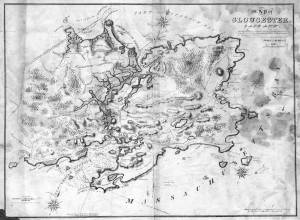
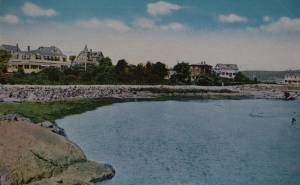
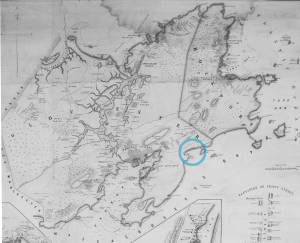
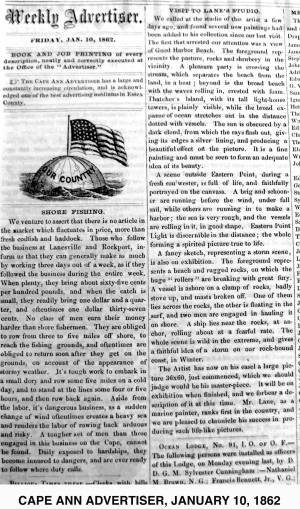
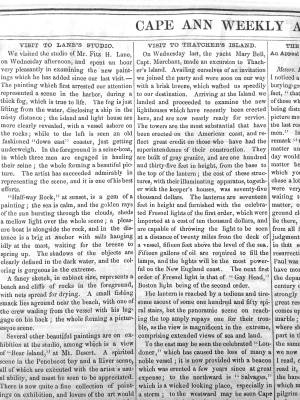
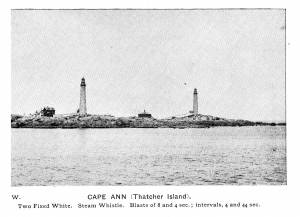

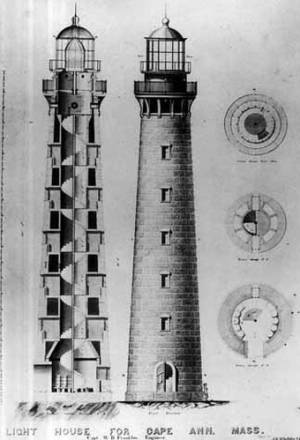
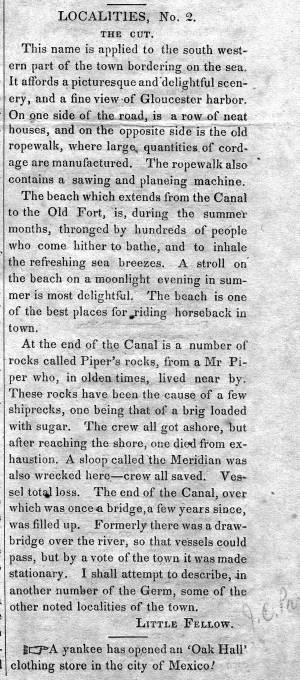
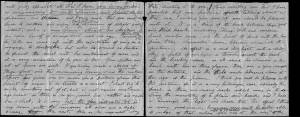
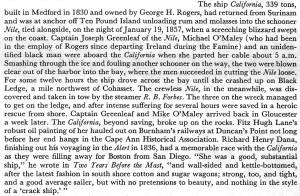
Supplementary Images